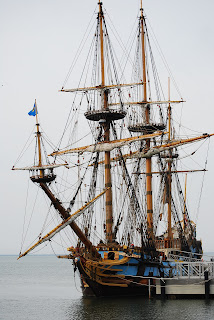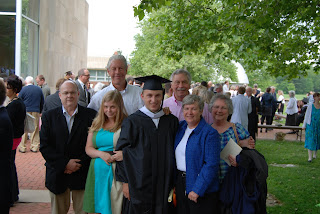“To the senior man and woman, who, through participation, leadership and sportsmanship, have contributed most to the SJC athletic program, a special blazer.”
Quoted from the program for the 2011 St. John’s College Commencement Exercises
In the photo above SJC Athletic Director (and 2011 commencement speaker) Leo Pickens assists 2011 award recipient Clayton Read Pasley into his "special blazer".
With two parents, two uncles, an aunt and a girlfriend looking on, Tex graduated from St. John’s College Sunday morning, the 219th commencement in the College's 315th year.
It was quite a day and quite a weekend.
Soon after we arrived in Annapolis we attended what Tex had described as a “little get together” put on by his recently-engaged housemates/landlords/fellow Johnnies; Kelsey Gilmore and Matthew Gore.
It turned out to be not a little get together but a full-fledged party, with a full layout of cheeses, shrimp, burgers on the grill, beer, wine, espresso and – get this – party favors. That was a very nice way to get the day started. Thank you Kelsey and Matt!
After checking in to the hotel and getting the vehicle parked (not as easy as it sounds) we met my brother Chet and his wife Sue, who traveled from New Hampshire, on the campus and the four of us along with Tex’s girlfriend Laurel Fischer (SJC, Class of 2010) attended an annual graduation weekend event known as “Class Day”.
In essence Class Day is a talent show and I want to put a lot of emphasis on the word talent. For more than two hours a dozen or so members of the SJC senior class treated a bladder-challenged audience of parents, grandparents, siblings and assorted others to a potpourri of music by combinations of voice, piano, guitar, violin and accordion. Poetry was read and a section of Jane Austen’s Pride and Prejudice was (hilariously) performed.
Adding to the aura the event took place in the “Great Hall” of McDowell Hall, a building originally intended to be the colonial governor’s mansion when it was constructed in 1742.
I am certainly not one to judge talent in areas such as Bach’s “Chaconne” on violin, or a piano piece by Schubert, but for whatever it may be worth I was very impressed with the talent these kids – er, young men and women - displayed.
Perhaps the most unusual performance – and I know readers may find this difficult to believe – involved Tex and two of his good friends, John Vining and Blake Myers. Now I am sure that most readers would have thought that, with the college president looking on from the audience, my son would be drawing the bow across the strings of violin, tinkling the keys of a piano, or perhaps singing a duet or reading a classic poem.
Nope, none of that stuffiness. Instead, Tex displayed his skills as a bartender.
John read the preface to, and Blake read the text of, what I would call a cross between a recipe for, and a romantic essay about, the mint julep.
(Note: I have posted this “recipe/essay” on a separate page on this blog. You can access it by going to the top of the main page of the blog where you will see headers titled “About the Blue Hen” “Tex’s Senior Essay” etc. On the far right of this list of separate pages is one titled “The Mint Julep”. If you take the pointer on your cursor and place it over the page tab and click once on that tab with the left clicker on your mouse it will take you to that page and you can read Soule Smith’s ode to the mint julep. To get back to the main page - i.e. the blog - click on home.)
As John read the preface Tex was at the back of the stage at a table setting up the various items that are needed to make a mint julep. Then, as Blake read the recipe/essay, Tex performed each of the tasks that were being described in the "ode". When Blake was finished reading, Tex had three mint juleps were ready for drinking.
The three of them then toasted one another and left the stage.
One of the inside jokes, which I did not realize until told later, was that Tex used the head of broken croquet mallet to pound the ice cubes into crushed ice (if you don't get that joke you have not been reading the blog).
I think it is fair to say that, among the many talents on display at Class Day, the performance by Tex, John and Blake stood out.
After Class Day we went to a reception, then to the patio of our hotel for a beer and some cigars and then to a restaurant where we were joined by John Vining and his family.
That was it for Saturday; at least as far as Chet, Sue, Betsy and Dave were concerned.
Sunday morning Betsy and I met her brother Rob for breakfast at Chick and Ruth’s, a famous Annapolis eatery, and then walked over to the campus.
The graduation was scheduled to be held on the front lawn of the campus (primarily, I think, so that there would be enough seating for everyone that wanted to attend). However, rain was forecast and skies threatened and the ceremony was moved indoors to the Francis Scott Key (SJC, Class of 1796) Auditorium. Each graduate got eight tickets apiece and, because there were exactly eight of us, the move inside was good even though it did not rain. I say good because it was warm and muggy outside and the seats in the auditorium were much more comfortable than the folding chairs would have been out on the lawn. The overflow watched from an adjacent room, via video.
After remarks from President Nelson and the singing of a well-known song written by 1796 SJC graduate F. S. Key, the awards were distributed. Just to give you a bit of the flavor of SJC, the best senior essay was titled "An Investigation into the Supposed Conflict Between Non-Eclidian Geometry and the Doctrine of the Transcendental Ideality of Space".
The commencement address was delivered by the school’s Athletic Director Leo Pickens, a 1978 graduate of the college. Tex was a member of the speaker selection committee and a strong advocate for Mr. Pickens' selection as the speaker.
Now, to many (admittedly, myself included), this would seem like an odd choice – a very mundane choice – for such an august occasion. With the exception of crew, St. John’s does not have any intercollegiate teams. Thus, Mr. Pickens is essentially the school’s intramural director. Not the kind of resume most folks would normally associate with a commencement speaker.
But most folks don’t understand St. John’s College. SJC is an inwardly focused institution that could care less about having someone with a high profile from the outside world come in to tell graduates about how to apply their college experience "in the real world".
St. John's isn't trying to mold students to fit into a particular niche, it is trying to prepare them to lead a life well-lived.
I am not going to spend a lot of time in this post trying to explain what SJC is about because I have already done that to some extent in the page with the heading “About SJC” and I am also providing a link to an article about President Nelson and the college that appeared on the front page of the metro section of Saturday’s Washington Post.
My take -way line from Mr. Pickens excellent address to the students was an advisory for them to “grow a big pair of ...(pause)... ears.”
In other words, focus on listening; both to yourself and to those around you. That was just one segment of his message but in a world that seems to have become increasingly shrill, an ever-narrowing cacophony of talkers, it just might be that those with the ability to listen and discern will be in great demand.
I am hopeful that Mr. Pickens' address will be posted soon so that I can copy it and post it on a page of this blog.
After the commencement there were the obligatory photos and champagne reception.
The seven of us went from the reception to a nearby restaurant for an excellent brunch. Rob then left for Atlanta and Tex and Laurel went off to begin the rest of their lives.
Chet, Sue, Betsy and I strolled around the Naval Academy grounds and downtown Annapolis.
By 8 p.m. we were back in Lewes, ready (or not) for our next chapter.







































